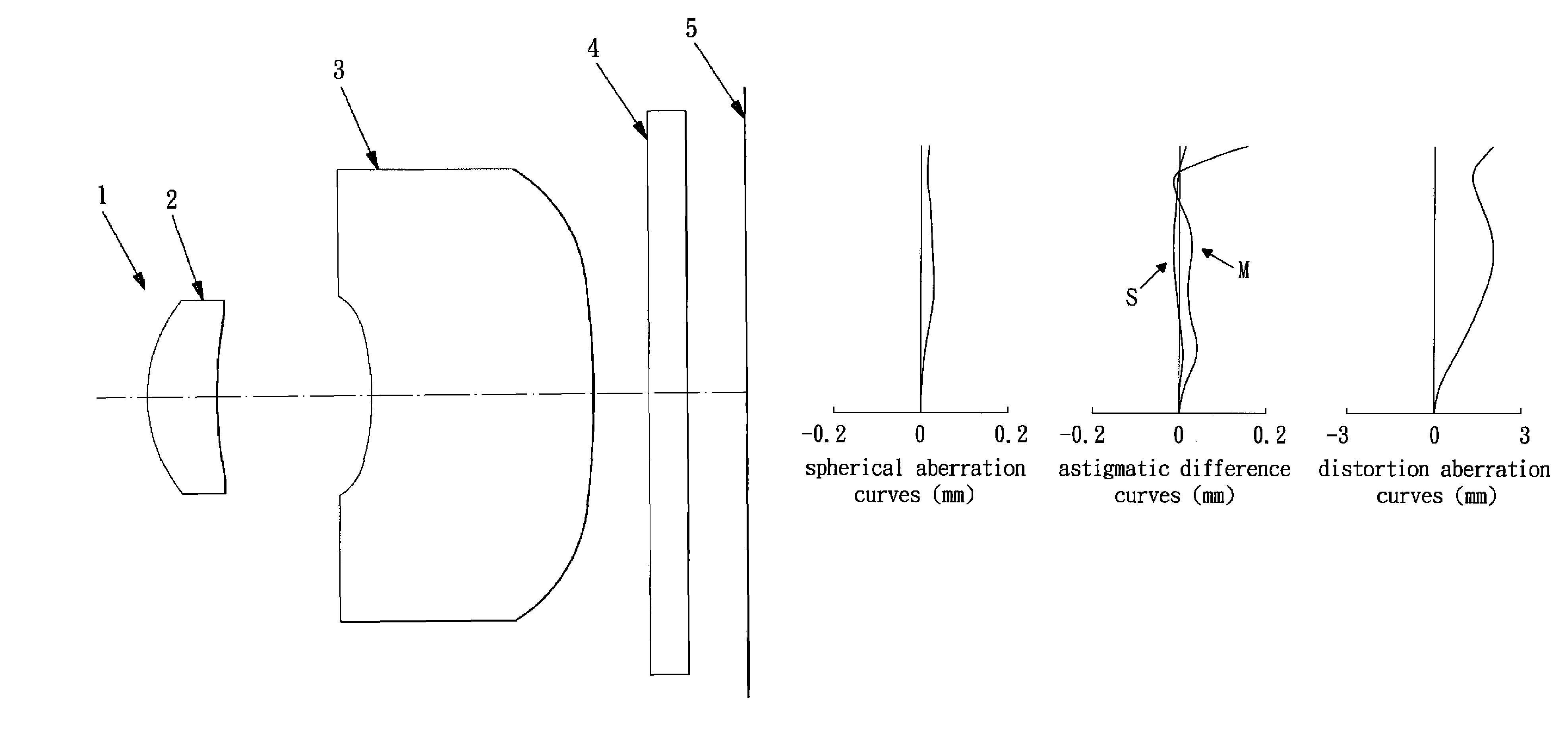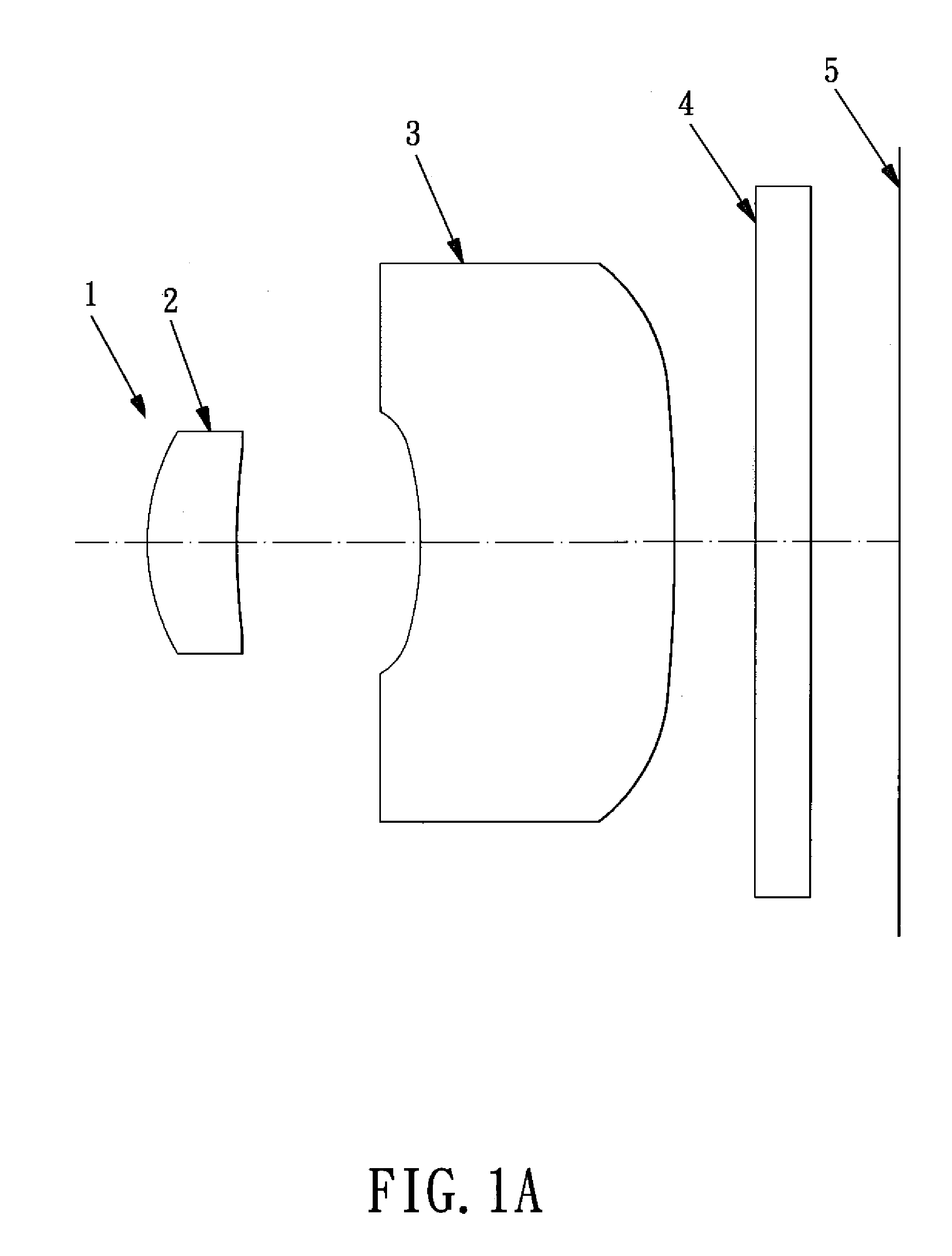Two-piece optical lens system for taking image
a two-piece optical lens and image technology, applied in the field of two-piece optical lens systems for taking images, can solve the problems of the cost of the first lens element made of glass, the incident angle of the optical lens system will get worse, and the incident angle of the optical lens system can still be slightly poor
- Summary
- Abstract
- Description
- Claims
- Application Information
AI Technical Summary
Benefits of technology
Problems solved by technology
Method used
Image
Examples
first embodiment
[0063]In the present optical lens system for taking image:
[0064]the focal length of the optical lens system for taking image is f, and F=4.00 mm
[0065]Fno.=3.21
[0066]field of view 2ω=59.1°
[0067]Referring to table 1A, the Arabic numbers 1, 2, . . . 6 represent the sequence number of the surfaces of the first lens element 2, the second lens element 3, and the parallel flat glass 4 from the object side. The r represents the paraxial radius of curvature (its unit is mm); d represents the thickness of the lens elements (its unit is mm); nd means the refractive index and νd means Abbe number. Numbers 5 and 6 represent both sides of the parallel flat glass 4 whose radius of curvature r is ∞. And all the embodiments of the present invention are the same in this point.
[0068]Table 1B shows the aspherical coefficients, the above surfaces of each lens element are aspheric. The aspherical coefficients of the respective lens elements are indicated by A, B, C, D and E, the height of the optical axi...
second embodiment
[0072]In the present optical lens system for taking image:
[0073]the focal length of the optical lens system for taking image is f, and f=4.62 mm
[0074]Fno.=2.92
[0075]field of view 2ω=56.0°
[0076]table 2A shows each component of the optical lens system, and table 2B shows the aspherical coefficient.
[0077]
TABLE 2ArDndνdAperture Stop∞0.00011.35620.5641.5434056.525.03551.2393−2.75961.8281.6320023.44−9.84180.4495∞0.3001.5168064.26∞0.488
[0078]
TABLE 2BSur-face#1234K =1.29242E−013.15006E−01−3.21073E−01−7.86269E+00A =−9.08382E−042.70775E−02−1.91369E−01−2.08962E−02B =−9.27818E−02−3.35055E−023.72625E−01−9.83922E−03C =6.37964E−01−1.38815E−01−2.20644E+006.10556E−03D =−2.50149E+004.33982E−016.22376E+00−4.02529E−03E =5.15472E+003.42007E−01−1.17844E+011.51404E−03
third embodiment
[0079]In the present optical lens system for taking image:
[0080]the focal length of the optical lens system for taking image is f, and f=3.14 mm
[0081]Fno.=3.22
[0082]field of view 2ω=58.1°
[0083]table 3A shows each component of the optical lens system, and table 3B shows the aspherical coefficient.
[0084]
TABLE 3ArdndνdAperture Stop∞0.00010.80610.4951.5434056.521.54230.7873−3.70960.7741.6320023.44−352.55980.2535∞0.5001.5168064.26∞0.400
[0085]
TABLE 3BSur-face#1234K =5.61761E−012.97022E−01−1.88710E+011.00000E+00A =−4.39698E−023.24764E−01−4.33358E−01−1.35113E−01B =−9.60236E−015.16416E−012.18731E−01−1.66172E−01C =9.73796E+002.85387E+00−1.59626E+013.39366E−01D =−7.15122E+01−1.75796E+011.40289E+02−3.16976E−01E =2.96511E+022.60540E+02−5.88477E+024.94315E−02
PUM
 Login to View More
Login to View More Abstract
Description
Claims
Application Information
 Login to View More
Login to View More - R&D
- Intellectual Property
- Life Sciences
- Materials
- Tech Scout
- Unparalleled Data Quality
- Higher Quality Content
- 60% Fewer Hallucinations
Browse by: Latest US Patents, China's latest patents, Technical Efficacy Thesaurus, Application Domain, Technology Topic, Popular Technical Reports.
© 2025 PatSnap. All rights reserved.Legal|Privacy policy|Modern Slavery Act Transparency Statement|Sitemap|About US| Contact US: help@patsnap.com



